Okay, so receptive language activities are one of my favorite things to do in therapy. I really don’t think it gets enough attention especially when you consider how impactful it is not only on receptive language skills but also on expressive language.
I have been waiting a long time to write this essay because I not only wanted to highlight the best receptive language activities but also share examples so that we know exactly how to help a child with a receptive language disorder. So bookmark this article and use this outline to click and jump down to any of the strategies you want to try out for yourself.
6 Evidence-Based Receptive Language Activities
When we think about receptive vs expressive language therapy, one thing that I can say anecdotally is that building on receptive language skills is way more fun. It is less demanding on the child, it involves all the senses, it is very different from their classroom routines. All of this adds together to be engaging and a good time.
Now, add to this the fact that research is showing that receptive language activities are showing expressive language gains and you have a very powerful tool at your disposal. Receptive language skills are the predecessor to many expressive abilities. This works for the very young and is evidenced by the order of acquisition of test items on tests like the MacArthur-Bates. It is also true for second-language acquisition where the number of words we can read and understand far outpaces what we can say.
There are going to be some oldies-but-goodies that you will recognize from this list but probably also some new tools for your toolkit. Let’s start with the WH questions.
1. WH Questions
Most SLPs, even those just coming out of grad school, effectively use WH questions and following directions to build receptive language skills. We are all pretty good at this. However, some speech pathologists are great at this. And when I say great, what I mean is that their students can generalize their abilities to the classroom and they move through their goals super quick.
How are they doing it? They are:
Taking concrete data
Data is the 4-letter-word of speech pathology. WH-Questions provides us with some of the easiest ways to collect data and we only need to count to 4. Simply use their homework as their data and don’t send it home until the 9 week grading period is over. Look at this example, if you count the WH questions for each section you get 4/4 or 16 total.
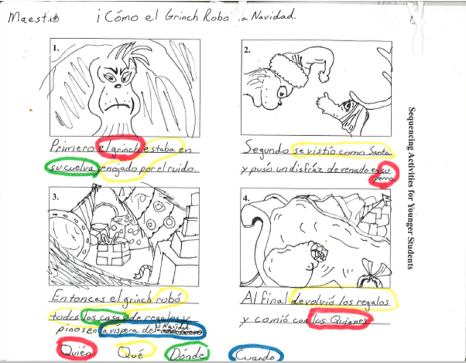
Not treating WH Questions as one big thing but are working on each question individually.
Many of us treat “WH questions.” That’s it, all lumped together. Child answers 7/10 questions correctly. But which ones? Let’s use phonology as an out-of the-box example.
Would you say: Child produced 7/10 sounds correctly? That’s right, just sounds. Of course not. We would say FCD/Clusters/Stopping, whatever they have going on. Would you focus on FCD if the child mastered it? Of course not.
Yet, with WH-Questions, many of us continue to ask WHAT questions after they are mastered. Or WHERE questions. We should focus on WHAT until it is fine, then move on to WHERE, etc. We should spend a whole week on WHEN if that is what is needed, not keep hopping around.
Using the same structure but changing the content
What we know that through curriculum based intervention research, and evidence-based practice around literacy based intervention, is that the book, the content can change as much as you want, but something has to stay the same to provide familiarity and repetitive structure.
For most of us, the way a child learns WH-Questions changes with each book and activity. If we keep the data the same, the child will know what is expected and have many more opportunities to practice. Here’s an example you can download from our Speech Therapy Materials page. You can use these mats that come out for each story or you can create and use the same dice week after week.

You can’t go wrong with WH Question dice. Just don’t use glue unless you want a huge mess. Scotch tape works best. And, if you send this home, it will be trashed in four seconds. It’s cool to have them around your room.
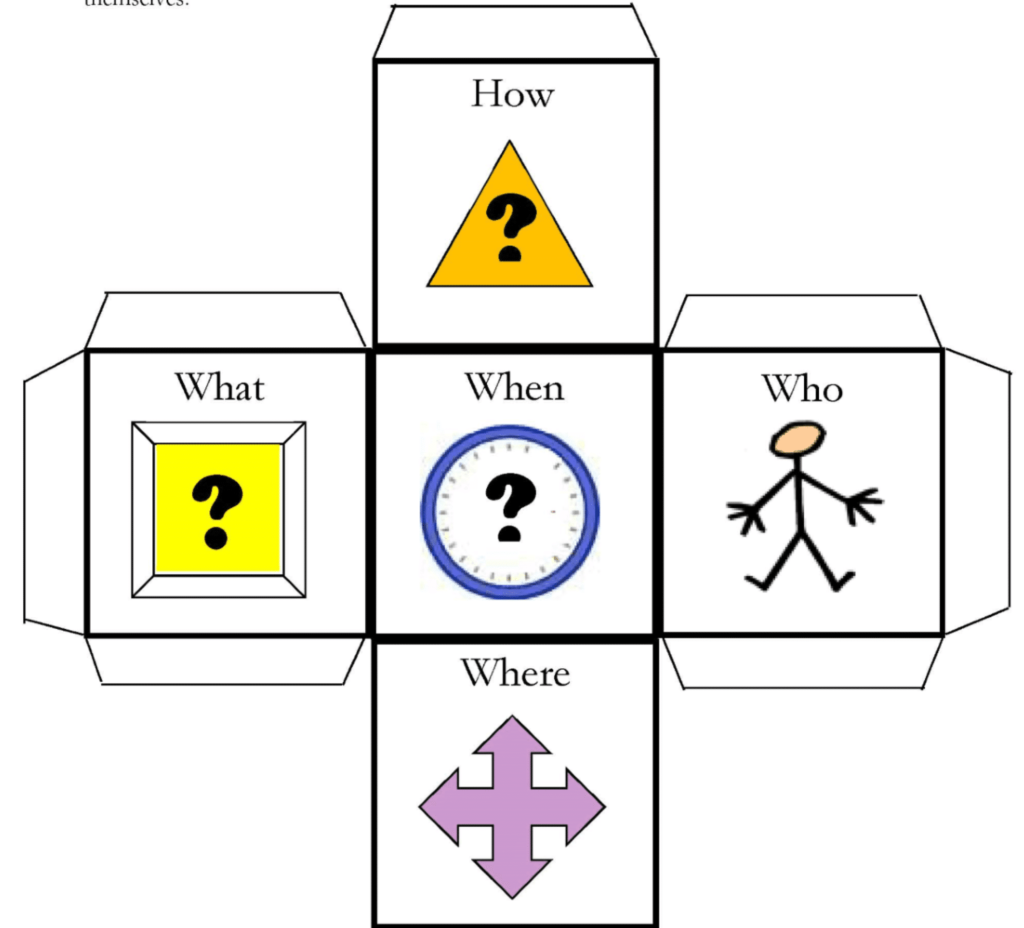
When WH Questions therapy works really well, we hammer on a single question or set of questions across multiple activities or books. Then we circle back. We focus on characters (WHO) for five books and circle back. We focus on location (WHERE) for five books and then circle back. All this adds up to generalization and solidifying the retention.
2. Vocabulary Retention
Vocabulary is something that teachers are very, very worried about. General education students are exposed to tons of new vocabulary every week. Thinking in terms of construction, we as speech language pathologists build the structure of a language. We are the framers building a house. The vocabulary iis the doors, the windows, the paint, the roof, all the things that hang on the structure. So when a teacher says the child isn’t retaining vocabulary, or can’t remember, what are they saying? I think they’re saying that they’re throwing those hundreds of words at them each week and they are not sticking. Where the structure is poor that the vocabulary doesn’t stick.

So our job is not teaching vocabulary but building the structure. We do this by focusing on the function, the attribute, and the category. The name, the part that seems the most important, is actually “recalled” as a result of a child’s familiarity with the object and ability to compare it to other things or group it.
We came up with this acronym to remind us what to work on. And just like with WH-Questions, if a child is struggling don’t focus on them all at once. Spend a week on object function and then rotate over to categories, etc.
How To Treat Receptive Language Disorder For Vocabulary
Focus on FACT:
- Function
- Attribute
- Category
- Therapy
3. Barrier Receptive Language Activities
Barrier activities are a way for us to not spend any money, dig through the recycling bin and have a ton of fun with kids. It also gives us direct access to testing and the ways in which children are working together or alone to produce an activity. I love these because if you’ve completely lost a child’s attention, or if you’ve been doing something for a while and you don’t know what else to do, it can be your savior.
What is a barrier activity for speech therapy?
Barrier activities are receptive language therapy activities where a barrier such as a manila folder is placed between the therapist and student. Each person has the same materials such as 5 blocks or the same color crayons. The listener follows directions to build, draw, or arrange objects. The speaker is doing the same thing. After the command, the barrier is lifted and if the sides are the same, the instruction was followed correctly.
There are two types of barrier activities: physical based and paper-based.
Physical-Based Barrier Activities
Physical-based barrier activities use objects.. It’s great for busy children because they have something to focus on. It combines following directions and paying attention. So watch a video here. Pay attention to how he starts this session. Basically he is not making any assumptions with this child. He makes sure the child knows the sizes, numbers, and colors so that he is truly testing his ability to follow directions.
Paper-Based Barrier Activities
So who are paper-based barrier activities for? This is for everybody. The lowest you can go with ages is great. It’s the easiest planning, because you can use the same shapes in the same activities for tons and tons of different groups. If it’s not related to a storybook, the trick is to make sure that it’s on grade level and using classroom concepts.
You can see in this example, that it’s two rooms and the same pieces of furniture. You can find tons of ideas on the internet but I would suggest you choose your favorite books and make your own. In these examples you will see easy and more difficult projects, all for the same book.
A tip for all receptive language activities is don’t glue them together. Just put them in Ziplocs and reassemble them for all your different groups.
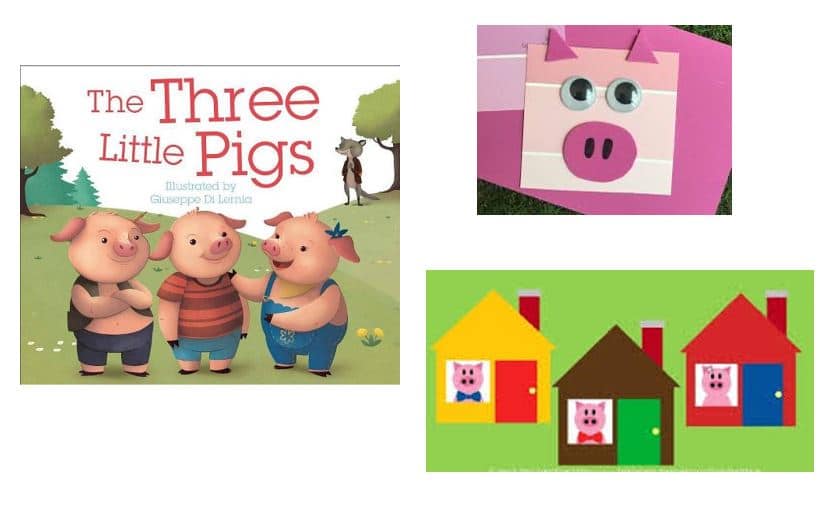
We can also go 3D. You know that someone’s got a closet full of sack lunch bags that they’re not using. They make brilliant houses. Here you can see that different activities happened with different pages on this book. And also that kids added the pages of the book to the mural on the wall.
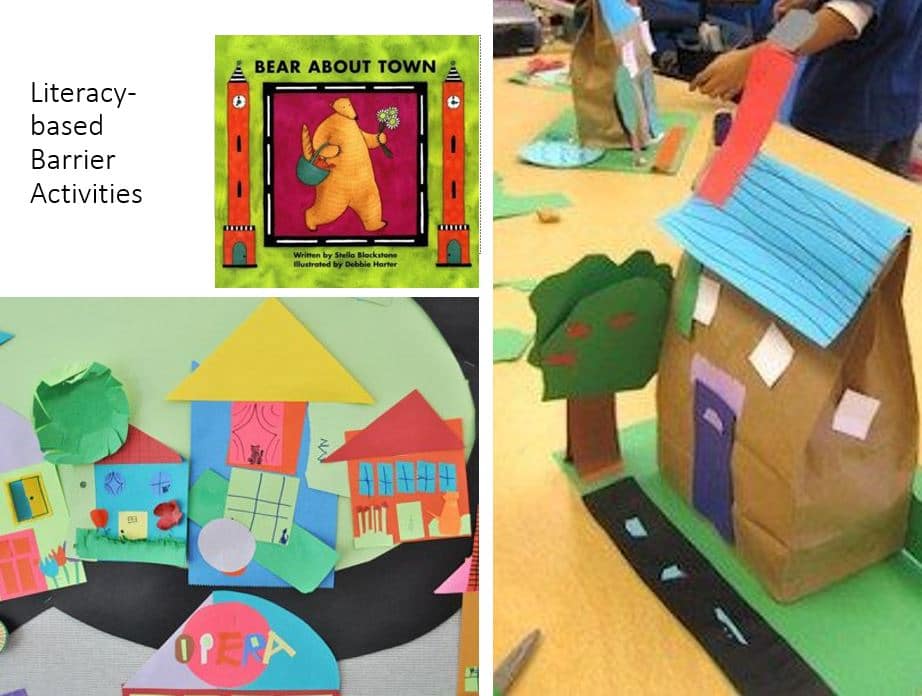
So by the end, each page of this book was identified in a barrier activity that was stuck up on the wall. I’m doing this across many, many goals and many, many groups to apply to the same mural.
The funniest thing about barrier activities is how nervous the students get in the end. When you lift up the barrier to see if theirs looks like yours they get excited. I have to admit that I am guilty of changing mine when working with the little ones :).
4. Following Directions Activities
Following direction activities are the other things that SLPs do pretty well. Here I want to deep dive a little bit further into what’s actually going on when a child’s developing these receptive language abilities.
I think that we often lack data to say what a child’s able to do. Children need to follow directions for safety and to learn. They need to follow them in their rooms, in the hallway, on the playground… These things come fast and furious, hundreds of times an hour, where they might not have the visual support. And they’re relying almost entirely on auditory support.
So we can use the visual and the other tactile modalities to build following directions skills so that it generalizes over to hearing only.
“Saying a child can’t follow directions is like getting a referral that says: Child doesn’t communicate. We know they do in some shape or form, just maybe not with words. The same is true for following directions. Can’t follow directions? At what level?”
Directions are made up of 1) steps and 2) components. Using this chart as an example, we see that “sit” = 1 step, 0 components where as “touch your nose” = 1 step, 1 component.
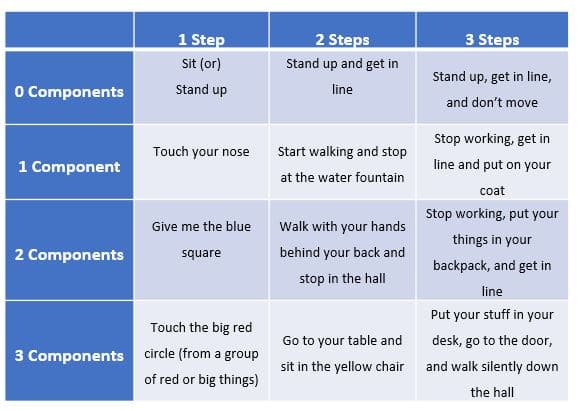
It’s not enough to say a child can’t follow directions. We need to start with data and work at the level the child is at. You can download a blank version which is great to take with you to a classroom observation
5. Silent Therapy
Silent therapy are receptive language skills activities that are 180 degrees out from barrier activities. The speech session is held with ZERO talking including you. Students follow your movements to complete a task. They are able to watch their buddies and even lean over to help them out.
Here is an example of making a paper airplane. At the end, you get to throw it and take it home which is pretty exciting.
What’s great about silent therapy is that it helps us rule out so many of the things that are confused with receptive language disorders:
- Hearing Impairment
- Second-language Influence
- Pragmatic Difficulties
- Attention Deficit
- Auditory Processing Issues
Additionally, I have had students that are pretty quiet most sessions who absolutely excel at this. They are the observers and we can get a true sense of the receptive language skills when we reduce the expressive language load.
Here are two of my favorite books with step-by-step instructions.

6. Game Making
Lastly, say it with me: “Speech pathologists, just _________ – play games.” You’ve heard that right? Well, it’s time for us to own it.
What I want to suggest, rather than spending your money on games and clouding your shelves, is that we make these games ourselves. This way we have games that a child can take home, that aligns with the curriculum, and aligns with our favorite storybooks. Here’s how to do it
Head on down to the recycling bin in the common area and grab all of the gently used manila folders. Now, we just need to lean on our Library Science brethren to figure out what to make.
I want you to think about something for a second:
“Board games are narratives.
A game is a plot.”
The library science people have done mad amounts of research defining what stories are. So I want to talk about their types of stories and how those ultimately translate to games. And that’s what makes this evidence-based because a game is a narrative.
Types of Stories to Make Games for Receptive Language Activities
We wrote essays on each of these but let’s use circular stories as an example. The character starts in a location, goes somewhere and comes back to that location. It’s most board games. In Where the Wild Things Are, Max left his bedroom, went to cross the sea to where the wild things are, crossed the sea again, and went back to his bedroom.
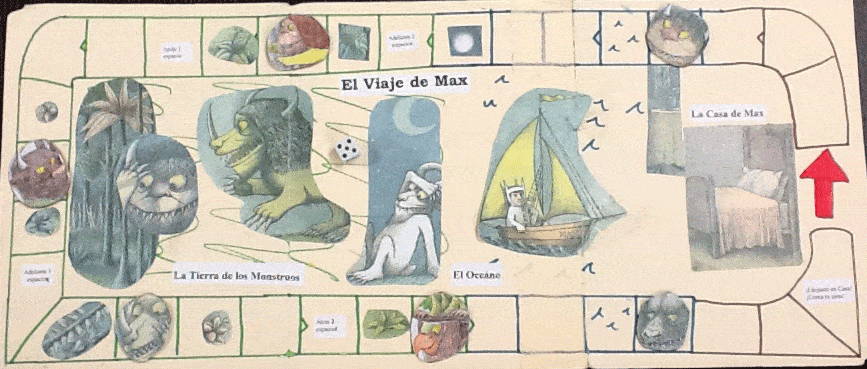
Cumulative stories? You get something, add to it, repeat the first thing, add the second. Repeat the first and second, add the third… This is like The Old Lady Who Swallowed a Fly.
Here is a game example from The Gigantic Turnip that I totally ripped off Trivial Pursuit to make:
And if you are completely devoid of game making skills you can almost always make BINGO. Just use the story’s vocabulary. In Bear on a Bike, he goes from place to place, to place in different modes of transportation. So these are the ways that the vocabulary gets introduced to the story.
Learn More:
Receptive Language Disorders and Delays – Share this with your parents
Receptive Language Goals That Pack A Punch
A New Approach for Receptive Language Strategies
The Power of Receptive Language – Earn CEUs and improve your receptive language game!




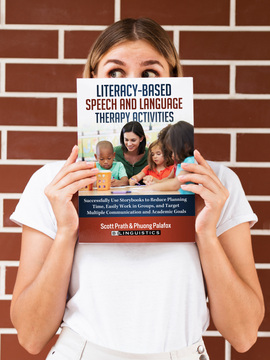
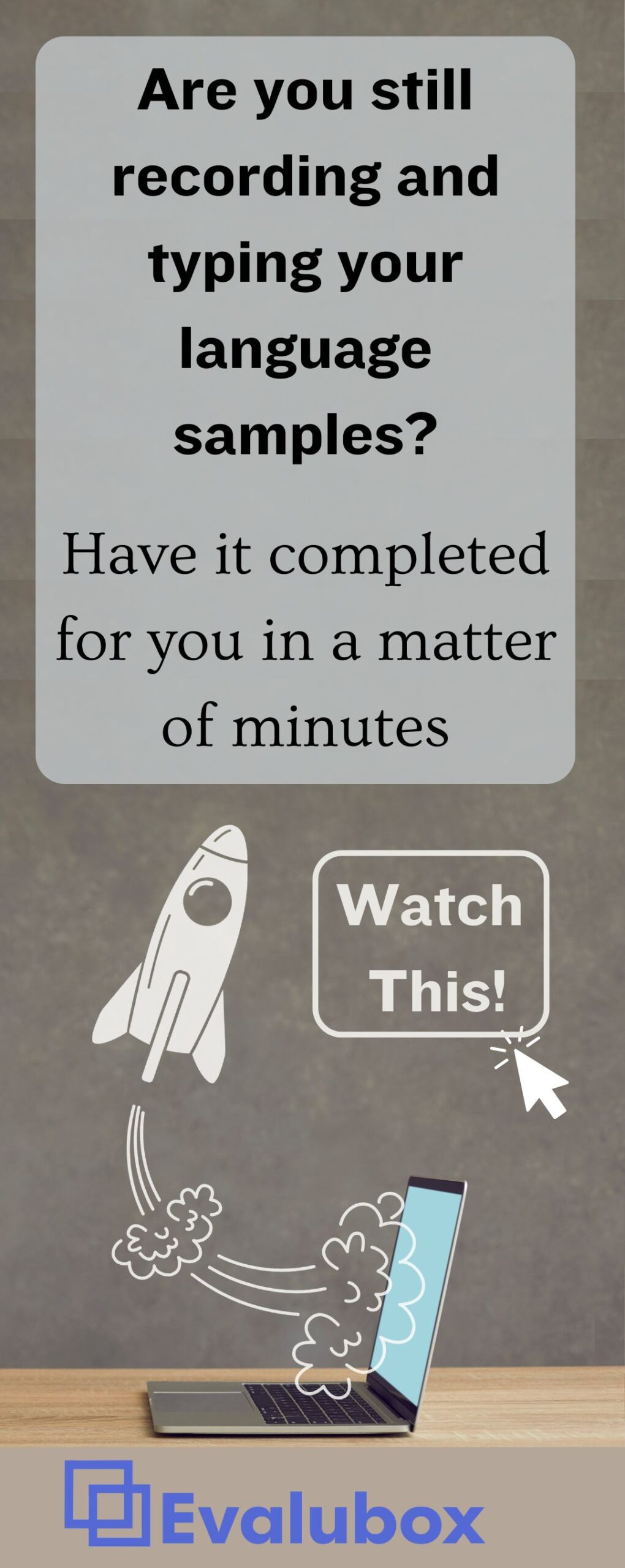
Great ideas! Love how you focus in on critical areas of skills to address without all the other garbage! None of the downloads work, however. At least not on my computer. Just sends me to your materials page. When I click on download it asks for my email–which I supply–and then I get the endlessly spinning dial…
Thank you for your comment! I replaced the two links to the dice and WH-Question maps. Some people have had trouble accessing the downloads and we think it is due to security issues on campuses. Thanks for the heads up and I will fix it.
This is such a great post! I am curious, how would you use the Where the Wild Things Are game board in a session? Also, would you consider making a board game therapy course? I would love to take a course like that!
Hi Natasha,
I could speak all day long about board games so that’s a great idea to make a course. We will consider adding that soon. The research has already been done and is in the Literacy-based book showing you how to pick books and use them for games in case you haven’t seen it.
Where the Wild Things Are is one of the best books to use because it spans so many ages. I use it for a mix of grades and a mix of disorders sitting around my table. Imagine a group with mixed goals of speech and language:
character descriptions as we each make monster game pieces
emotional descriptions of Max and the monsters throughout for pragmatics
consequences of Max’s actions – pragmatics
I have a list of all the words in the book, specifically r,s,l lists plus clusters. Artic kids say their words before rolling
We pause on each fourth of the board to discuss sequencing. Each side is a word first-then-after-at the end
categorization of monster parts – pausing and making monster puppets out of lunch bags.
Roll the dice to follow directions
As you can see, there is a done of pre-work going on. The board game is played across many sessions and is the reword for other work. The goal is that at the end they could tell the story as well as they could tell you about their favorite movie.